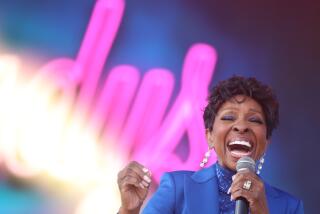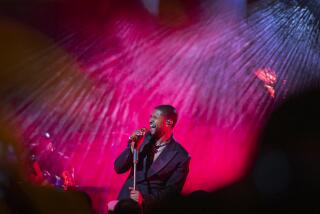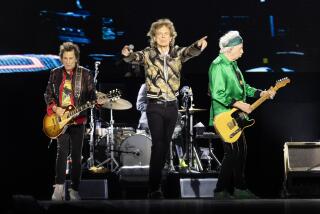It’s Radiohead’s New Broadcast
Radiohead’s highs ranged from brilliant to breathtaking Friday at the Santa Barbara Bowl, a performance that reaffirmed the British group’s place as the only true rival to U2’s position as the greatest contemporary rock band.
But the most revealing moment in the more than two-hour concert may have been a 30-second sequence between songs.
Lead singer Thom Yorke is normally so stone-faced that it certainly caught your eye when he returned to the stage with a mischievous smile for the second of the group’s three encores.
He looked out at the enthusiastic crowd and asked playfully if it really wanted to hear some more music. That’s like asking a caffeine addict if he really wants that first cup of coffee of the morning.
The fans, who had already been on their feet for the entire concert, cheered wildly.
What made the moment special was that you could tell from Yorke’s upbeat manner that he and the rest of the group wanted to play more tunes as much as the audience wanted to hear them.
One reason for excitement on both sides of the spotlights is that this is Radiohead’s first formal U.S. tour in three years, and it follows a period of such uncertainty that many wondered if they would ever see the band again.
Radiohead, whose music can be both enchantingly cerebral and uncompromisingly visceral, was burned out after the extensive touring that followed the worldwide commercial breakthrough in 1997 of its album, “OK Computer.” The collection was an icy look at alienation that was far more bleak and deeply rooted than the normal teenage complaints associated with the term “alienation” in rock.
The band seemed as drained by the end of those shows as the world they talked about in “OK Computer,” a situation that raised chilling questions among the members themselves about whether they could survive at such a grueling, high-profile level.
Even more significantly, Yorke seemed bored with rock. He wondered if the band’s emphasis on guitars and traditional song structures offered him sufficient range to pursue his musical vision, which was growing increasingly desolate. He felt there was more inspiration and range in the chiefly instrumental music coming out of the electronica world.
That’s why the band drew upon some electronica trademarks in its last two albums, 2000’s “Kid A” and the new “Amnesiac.” Through released separately, the albums were recorded at the same time and serve as companion pieces.
Radiohead did a couple of showcase dates in the U.S. after “Kid A” last year, including one at the Greek Theatre in Los Angeles. But the group’s manner seemed restrained, as if it was just testing the waters.
There was no sense of that uncertainty Friday.
Following an opening set by the quirky but extremely tuneful Beta Band, Radiohead was on fire from the beginning. In both its playing and in its triumphant body language, the group seemed liberated--fused with a new confidence because it has an even wider musical canvas, thanks to its experimentation with the electronica elements.
Though the band employs some computer-driven touches, they are mostly as punctuation for the renewed focus on guitar, which is supplied by Yorke, Ed O’Brien and, especially, Jonny Greenwood, whose tasteful work also on keyboards earned him the title of tour’s MVP instrumentalist. Drummer Phil Selway and bassist Colin Greenwood complement them seamlessly.
One sign of the band’s confidence is that it didn’t feel the need to answer those critics and fans who saw the more atmospheric style of “Kid A” and “Amnesiac” as a retreat from the more accessible foundations of its previous “The Bends” and “OK Computer” albums.
To reassert their belief in the new works, they could easily have stubbornly decided to simply play the music from the two albums in sequence. Instead, the band mixed a half-dozen or so tunes from each of those two albums with an equal number from “OK Computer” and a lesser number from “The Bends.”
As the band proceeded through such numbers as “Morning Bell,” “My Iron Lung,” “Karma Police” and “You and Whose Army?,” you weren’t focused on which album the music was coming from, but the excellence of the body of work.
Unlike U2, Yorke and his mates don’t try to funnel their creative energies into accessible anthems that reach out to an audience that encompasses the entire pop stratum. Radiohead’s music seems much more inner-designed. That’s why you can appreciate Yorke’s attempt to stretch beyond the traditional pop-rock song reliance on melody and verse-chorus-verse structure.
In “Kid A” and “Amnesiac,” Yorke reduces lyrics to a series of random images, often distorting or slurring them vocally in ways that add to their abstractness.
Similarly Friday, Yorke was sometimes more effective in communicating the nuances of the songs by sidestepping careful clarity for simply pure feeling, as in moments when he employed the lonesome beauty of a falsetto wail. However dark the music, the effect is inspiring and hopeful.
The group’s musical approach was echoed imaginatively on the video screens at both sides of the stage. Normally, the goal of the screens is to present clear images of the acts to create a greater sense of intimacy in the facility.
But the images Friday were frequently as abstract as the music, fading in and out of focus in keeping with the mood of the songs. The goal wasn’t to have you better see the performers, but feel the emotional depth of the music. It was a statement of priorities that underscores the originality of the Radiohead’s music and its vision. The band, which played a second sold-out show Saturday at the Santa Barbara Bowl, performs Aug. 20 at the Hollywood Bowl.
More to Read
The biggest entertainment stories
Get our big stories about Hollywood, film, television, music, arts, culture and more right in your inbox as soon as they publish.
You may occasionally receive promotional content from the Los Angeles Times.










